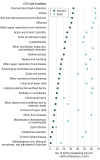Availability of Definitive Hospital Care for Children
- PMID: 28692729
- PMCID: PMC6583506
- DOI: 10.1001/jamapediatrics.2017.1096
Availability of Definitive Hospital Care for Children
Abstract
Importance: Timely and efficient access to hospital care is essential for the health and well-being of children. As insurance networks, accountable care organizations, and alternative payment methods evolve, these new systems of care must continue to serve the needs of children.
Objective: To test the hypothesis that the availability of definitive pediatric hospital care is significantly more limited than adult care and is decreasing disproportionately.
Design: This study used case mix data during fiscal years 2004 through 2014 to measure transfer frequency and identify the site of care completion for all patients seen in acute care hospitals throughout Massachusetts. Patterns of care among children were then compared with patterns of care among adults. Participants were all patients seen in an emergency department or admitted to a hospital from 2004 through 2014, including more than 34 million encounters.
Main outcomes and measures: Hospital Capability Index and Regionalization Index for all acute care hospitals and all conditions within the Clinical Classifications Software of the Healthcare Cost and Utilization Project.
Results: Over the study period, the Commonwealth of Massachusetts hospital system was composed of 66 acute care hospitals. After excluding newborns and mental health conditions, there were 34 511 312 encounters, with 25 226 014 emergency department visits and 9 285 298 observation or full admissions. From 2004 through 2014, care for adults and children concentrated among hospitals but much more so for pediatric care. The number of children requiring care in more than one hospital increased 36.2% (from 7190 to 9793). The median (interquartile range [IQR]) Hospital Capability Index, reflecting the likelihood of a hospital completing a patient's care without transfer, decreased 10.8% (from 0.74 [IQR, 0.65-0.81] to 0.66 [IQR, 0.53-0.76]) for adult care and 65.0% (0.20 [IQR, 0.05-0.34] to 0.07 [IQR, 0.01-0.23]) for pediatric care. Almost all of the shift was from nonacademic to academic hospitals. The median Regionalization Index, reflecting the degree to which care for specific conditions is regionalized, was very high for pediatric conditions and further increased from 0.79 (IQR, 0.67-0.91) to 0.87 (IQR, 0.80-0.91). Over the same decade, the mean Regionalization Index for adult conditions was low and increased modestly from 0.25 (IQR, 0.14-0.39) to 0.32 (IQR, 0.19-0.46). Among pediatric conditions, more than 75% were highly regionalized in 2014 compared with fewer than 50% in 2004.
Conclusions and relevance: Pediatric hospital care has become increasingly concentrated, and many children with common conditions are now less frequently treated in the community. This finding has significant implications for systemwide capacity management and should be specifically accounted for in public health activities, disaster planning, and determinations of network adequacy.
Conflict of interest statement
Figures




References
-
- Sigrest TD; American Academy of Pediatrics Committee on Hospital Care . Facilities and equipment for the care of pediatric patients in a community hospital. Pediatrics. 2003;111(5, pt 1):-. - PubMed
-
- Yamamoto LG; American Academy of Pediatrics Committee on Pediatric Emergency Medicine . Access to optimal emergency care for children. Pediatrics. 2007;119(1):161-164. - PubMed
-
- Klein MD; Surgical Advisory Panel, American Academy of Pediatrics . Referral to pediatric surgical specialists. Pediatrics. 2014;133(2):350-356. - PubMed
-
- Birkmeyer JD, Siewers AE, Finlayson EVA, et al. . Hospital volume and surgical mortality in the United States. N Engl J Med. 2002;346(15):1128-1137. - PubMed
-
- Horeczko T, Marcin JP, Kahn JM, Sapien RE; Consortium of Regionalization Efforts in Emergency Medical Services for Children (CORE-EMSC) . Urban and rural patterns in emergent pediatric transfer: a call for regionalization. J Rural Health. 2014;30(3):252-258. - PubMed
Publication types
MeSH terms
LinkOut - more resources
Full Text Sources
Other Literature Sources
Research Materials

